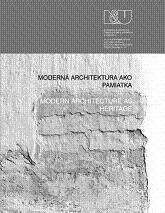VÝVOJ NÁZOROV NA OBNOVU ARCHITEKTÚRY MODERNÉHO HNUTIA: PRÍPAD SLOVENSKO
THE EVOLUTION OF PERSPECTIVES IN RESTORATION OF MODERN MOVEMENT ARCHITECTURE: CASE SLOVAKIA
Author(s): Henrieta MoravčíkováSubject(s): Cultural Essay, Political Essay, Societal Essay
Published by: Historický ústav SAV, v. v. i.
Keywords: Modern Movement architecture; restoration; Slovakia; protection; evaluation; listing; intervention; change; original; method
Summary/Abstract: The present study is aimed at presenting the nearly fifty-year-long history of the protection and restoration of architecture arising from the Modern Movement in Slovakia. It concerns the point when and how Modernist architecture began to be noticed by the landmarks authorities, and analyses the current state of Slovakia’s central landmarks register. Using selected examples of the rebuilding of works of modern architecture, it endeavours to show how opinions changed in Slovakia regarding this question, how they reacted to international trends and how their perspectives can be viewed at present. During the mid-1980s, a rediscovery occurred in Slovakia of the architecture of the interwar years, both by rchitectural historians and by practicing architects. This trend made itself apparent both in the focus of research and publications on the part of individual scholars, as well as increased attention devoted by state institutions to the architecture of the first half of the 20th century. Interest in the interwar architectural heritage grew still more powerful following the fall of Communism in 1989. On a professional level, the process was spurred still further by the initiative created to preserve the legacy of the Modern Movement, started in the Netherlands in 1988 and by 1990 culminating in the foundation of an nternational organisation for the documentation and protection of buildings, towns and communities of the Modern Movement, DOCOMOMO International. From the very beginning, experts from Slovakia took part in this procedure: the Slovak working group of DOCOMOMO is in fact one of the very oldest in this organisation. At the same time, a sizeable number of works of Functionalist architecture were, after over half a century of existence, urgently in need of restoration. Many of these buildings had suffered from insufficient maintenance or outright neglect as a result of the shift in ownership relations for newly privatised properties. Particularly vulnerable were industrial buildings or smaller instances of Functionalist architecture, yet even some of the monuments of post-war Modernism were not immune. Fortunately, the heritage community in Slovakia began to take an interest in modern architecture relatively quickly. The first entry of works of modern architecture in the central national landmarks register took place in 1963. However, these buildings were only a limited number of works that more accurately belonged to the ‘proto-modern’ architecture of the turn of the century. During the next major round of registration in 1980 – 1982, however, Functionalist architecture entered into the scope, and the majority of the most important works of Modern Movement were entered into the heritage records by the end of the 20th century. Currently, the list of registered landmarks includes around 250 works of modern architecture. Yet these buildings almost exclusively date from the first half of the 20th century; the one post-war building under
Journal: Architektúra & Urbanizmus
- Issue Year: 44/2010
- Issue No: 3-4
- Page Range: 180-199
- Page Count: 20
- Language: Slovak

